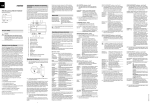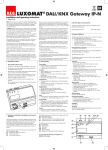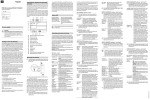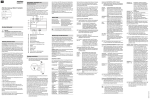Download BUS/KNX modular controller for dimming
Transcript
87045 LIMOGES Cedex France Telephone: (+33) 05 55 06 87 87 - Fax: (+33) 05 55 06 88 88 BUS/KNX modular controller for dimming - DALI protocol Catalogue number(s): 0 026 35 CONTENTS Page 1. Functions . . . . . . . . . . . . . . . . . . . . . . . . . . . . . . . . . . . . . . . . . . . 1 2. Technical features . . . . . . . . . . . . . . . . . . . . . . . . . . . . . . . . . . . . 2 3. Location and function of the control and display elements . . . . . . . . . . . . . . . . . . . . . . . . . . . . . . . . . . . . . 2 4. Connection . . . . . . . . . . . . . . . . . . . . . . . . . . . . . . . . . . . . . . . . . 3 5. Menu operation and structure . . . . . . . . . . . . . . . . . . . . . . . . . . . 3 6. Commissioning . . . . . . . . . . . . . . . . . . . . . . . . . . . . . . . . . . . . . . 7 7. Communication objects . . . . . . . . . . . . . . . . . . . . . . . . . . . . . . . . 9 8. Parameters . . . . . . . . . . . . . . . . . . . . . . . . . . . . . . . . . . . . . . . . 11 9. Behaviour on voltage failure and recovery . . . . . . . . . . . . . . . . 14 1. FUNCTIONS 1. FUNCTIONS (continued) The DALI modular controller combines the cross-functional KNX installation bus and the DALI bus specifically designed for lighting control. 1.2 Commissioning via embedded Web server In addition to the KNX/DALI interface, the DALI modular controller also has an RJ 45 interface which can be used to connect the device to an existing IP network. The embedded Web server makes it very simple to commission DALI using any Internet browser. The IP address, programmed with ETS or allocated by a DHCP server, is entered in a browser. It is also possible to access the Internet via a WLAN connection. The commissioning site is designed so that it can be displayed on a portable PDA. This allows the technician responsible for commissioning to move freely around the device. It is thus possible to integrate lamps equipped with light-duty digital DALI ECGs in a global KNX architecture and control them from a number of existing KNX devices. The DALI modular controller acts as both DALI master interface and power supply for a maximum of 64 connected ECGs. The ECGs can be switched, attenuated or set with a value defined in a maximum of 16 groups per gateway. The actual light value or the error status of each group (error status of ECGs/lamps in each group) can be exported, for example, to a display interface via a KNX gateway. The DALI modular controller can be used not only to control the group, but also to control up to 64 ECGs. In the latter case, there is one object per ECG. A parameter determines if each ECG should be switched, attenuated or set to a defined value. An error status object is available for each ECG. This allows lamps and ECGs with an anomaly to be located precisely. Three objects can be used for total control of all the ECGs connected via Broadcast (no DALI needs to be commissioned in this case). Moreover, the device has binary inputs. It is possible to enable functions directly using simple push-buttons connected to the device. The push-button function is available without an existing KNX bus and is particularly useful for the installation phase (operations performed on site). A modular device (6 modules), the DALI modular controller can be mounted directly on a 35 mm DIN rail in standard sub-distribution. The connection to the bus uses a standard bus coupler. DALI, the power supply and the push-buttons are connected using screw-type connectors. The device can be controlled via the application program. In addition, each group can be used to program and load up to 16 lighting scenes. Scenes are controlled by a 1-byte object. Thanks to the DALI modular controller, it is possible to commission the DALI (assignment of DALI ECGs to the various groups and modification of the configuration) in two different ways. 1.1 Commissioning via the device The DALI can be commissioned from the integrated screen and programming buttons, without KNX and without prior ETS programming. This method is particularly recommended when the DALI is installed by an electrician and the ETS software is programmed at a later date by a systems integrator. Technical data sheet: S000064593EN-1 CONTENTS Updated on: Created on: 15/06/2012 1/14 BUS/KNX modular controller for dimming - DALI protocol Catalogue number(s): 0 0 26 35 2. TECHNICAL FEATURES 2. TECHNICAL FEATURES (continued) Power supply • Power supply 110 to 240 V, 50 to 60 Hz, 0.1 A max. • Additional power supply via the KNX bus Electrical safety • Degree of pollution: 2 • Protection (in accordance with standard EN 60529): IP20 • Protection class: (in accordance with standard IEC 1140) I • Overvoltage class: III • Bus: Safety extra low voltage (SELV) 24 V DC Control elements • Programming button for toggling between normal mode and addressing mode • 3 buttons (MOVE, Prg/Set, ESC) on the front can be used to set the device and the parameters Conformity to electromagnetic compatibility standards Conforms to standards EN 50081-1, EN 50082-2 and EN50090-2-2 Display elements • Red LED indicating whether the device is operating in normal mode or in addressing mode • Green PWR LED indicating that the device is ready to operate (flashes in normal operating mode) • Red ERR LED indicating error status. • 2 x 12-character display for navigating through the menus for commissioning and parameter setting Environmental specifications • Resistance to the weather: EN 50090-2-2 • Operating temperature: 0°C to +45°C • Storage temperature: -25°C to +70°C • Relative humidity (non-condensing): 5 to 93% Inputs • Volt-free binary input, passive for connecting push-buttons or the 9-32 V DC or 8-26 V AC presence sensor, max. wire length: 15 m CE certified DALI bus • Connection of 64 ECGs maximum, in accordance with standard IEC 60926 • DALI 18-21 V DC voltage, short-circuit protection • No other control device (master DALI devices) should be used Ethernet • IP connection via Ethernet, rate 10 Mbps, only used for commissioning DALI • IP address assignment by a DHCP service or fixed IP address Connectors • Bus line: KNX bus coupler • Power supply: 3 x 1.5 mm² screw-type connector with single-core cable or threaded conductor • DALI bus: 3 x 1.5 mm² screw-type connector with single-core cable or threaded conductor • Binary input: 3 x 1.5 mm² screw-type connector with single-core cable or threaded conductor • Ethernet: RJ 45 socket for standard connection cable Certification KNX approved 3. L OCATION AND FUNCTION OF THE CONTROL AND DISPLAY ELEMENTS The device connectors and the LED and programming button, which are necessary elements for commissioning, are only accessible once the switchboard cover has been lifted out of the way. However, the programming buttons (MOVE, Prg/Set, ESC), which are necessary elements for commissioning the DALI interface and setting the parameters, can be enabled with the cover closed. The two-line menu display and the control LEDs (PWR and ERR) can also be read with the cover closed. Connector passive binary input 1 Connector passive binary input 2 DALI connector Operating LED Mechanical characteristics • Case: Plastic PA66 – V0 • Case dimensions: • Weight : 200 g MOVE button Prg/Set button ESC button 2 x 12-character display for configuring the DALI interface 86 106 Programming button Programming LED 55 RJ 45 socket for the Ethernet connection Error LED Always comply with the connector labelling on the case. • Mounting: On 35 mm DIN rail Technical data sheet: S000064593EN-1 CONTENTS Updated on: Created on: 15/06/2012 2/14 BUS/KNX modular controller for dimming - DALI protocol Catalogue number(s): 0 0 26 35 4. CONNECTION 5. MENU OPERATION AND STRUCTURE The DaliControl SC64 is a modular device, designed to be mounted directly on a 35 mm DIN rail in the switchboard. After clipping the device on the rail, the DALI bus should be linked to the connector in the top left-hand corner. In accordance with IEC 90929, the DALI interface control wires can be part of a 5-wire cable which also powers the ECGs (the basic insulation is adequate). However, each wire should be clearly marked and identified precisely. The maximum wiring length of a complete DALI installation on the same segment must not exceed 300 m. (Recommended cable cross-section: 1.5 mm²). The connected DALI segment can be switched on using the three programming buttons (MOVE, Prg/Set, ESC) and the 2 x 12-character display on the front of the device. The DALI parameters can then be set or changed using these buttons and the display. Operation of this device is controlled using menus. Depending on the current position in the menus, up to two submenus can be accessed. The selected menu element is displayed on screen. The user navigates around the menu by pressing the buttons briefly. The Move button can be used to select the next menu element on each level. The Prg/Set button can be pressed quickly to select the submenu. The ESC button can be used to exit the current menu level and return to the higher menu element. The power supply is connected to the connector in the bottom right‑hand corner, in accordance with the diagram on the device. The KNX cable is connected using a standard bus connector, already inserted in the unit when the device is supplied. A basic double insulation adapted between the KNX installation and the power supply must be provided. It is therefore necessary to sheath, using the retractable sleeve supplied, the KNX control wires, from the end of the cable to the bus connector. Once the device has been connected and the power supply enabled, the product name and the firmware version appear on the device display. The green PWR LED flashes to indicate that the device is ready to use. If the device is switched on without KNX, the red error LED lights up. If the ERR LED remains lit after connecting the KNX, there is probably a short-circuit in the DALI interface segments (see SYSTEM TEST submenu). In this case, check the wiring on the relevant DALI interface segment. The DALI modular controller also makes it easy to commission a Dali segment via the embedded Web server. To do this, the device has an RJ 45 socket on top of the bus coupler, in the device bottom right-hand corner. The device can be connected to a selector switch or an IP network router (Ethernet) using a standard connection cable. The connection is usually only required for commissioning and can therefore be temporary. Once the commissioning process is complete, the Ethernet connection is no longer necessary. When the power supply is connected, ensure sufficient distance is kept between the IP cable and the power supply cable. 5.1 Main menu – Level 1 The main menu (level 1) is structured as follows: DALI Control SC64IP,V.2.1 The product name and the firmware version are displayed. This screen has a submenu which can be used to select the display language. IP ADDRESS This submenu displays the IP address assigned by the DHCP server or defined in the ETS software. NEW INSTALLATION POSTINSTALLATION GROUP ASSIGNMENT In the submenus in this screen, the user can assign the detected ECGs to the DALI groups of his choice. GROUP PARAMETERS The submenus in this screen can be used to define and change the parameters in each group. SCENE ASSIGNMENT DALI ECG x 64 max. BUS (RJ 45) Ethernet This submenu can be used to switch the whole installation (Broadcast) and each of the channels for test purposes. TEST SCENES This submenu can be used to invoke the programmed scenes individually for test purposes. FUNCTION INPUT B1 FUNCTION INPUT B2 Technical data sheet: S000064593EN-1 CONTENTS Updated on: In these submenus, the user can assign the groups to DALI scenes. GROUP TEST SYSTEM TEST KNX This submenu can be used to reset all the connected DALI devices and launches automatic detection of the ECGs when a new DALI segment is installed. This submenu can be used to detect and automatically synchronize the DALI ECG configuration once these have been installed. This submenu displays all the existing system errors one by one. In the submenus in this screen, it is possible to define the function of binary input B1. --- Same as above --- Created on: 15/06/2012 3/14 BUS/KNX modular controller for dimming - DALI protocol Catalogue number(s): 0 0 26 35 5. MENU OPERATION AND STRUCTURE (continued) 5. MENU OPERATION AND STRUCTURE (continued) If a function needs to be enabled or if a parameter needs to be changed in a given submenu, it is necessary to switch to programming mode at the selected point. To do this, press the Prg/Set button and hold it down for at least 2 seconds. Once the selected function is in programming mode, the → symbol appears on the screen. Once programming mode has been enabled, use the Move button to modify the setting or the parameter. The Prg/Set button can be pressed briefly to end the procedure. The updated parameter is saved or the selected function is enabled. POST-INSTALLATION POSTINSTALLATION SEARCH ECG via P-MODE 5.2 Submenu – Level 2 and 3 DALI CONTROL DALI Control SC64IP,V.2.1 LANGUAGE FRENCH The DALI CONTROL main menu is used to access the LANGUAGES submenu. To do this, press the Prg/Set button briefly. The currently selected language is displayed in the submenu. Enable programming mode by pressing the Prg/Set button and holding it down for at least 2 seconds. Use the Move button to browse the available languages: GERMAN, ENGLISH, FRENCH, SPANISH, SWEDISH. The Prg/Set button can be pressed briefly to enable the new language and change the display as a result. Detected ECGs : 3 New ECGs: 1 DEL./NEW ECGs: 3/1 IP ADDRESS IP ADDRESS IP: 192. 168.004.101 The Prg/Set button can be pressed briefly to change from the IP ADDRESS main menu to the submenu. This submenu displays the IP address assigned by the DHCP server or defined in the ETS software. This setting cannot be modified on the device. This is done in the ETS software or via the DHCP server. NEW INSTALLATION SEARCH ECG via P-MODE Detected ECGs: 47 The Prg/Set button can be pressed briefly to change from the NEW INSTALLATION main menu to the SEARCH ECG submenu via the PROGRAMMING mode. Pressing and holding down the Prg/Set button sets the device to programming mode. Pressing again, briefly this time, launches the reset and search procedure. Initially, all the new ECGs connected to the DALI segment are automatically reset and the previous group parameters and assignments are deleted. The connected ECGs are searched for using their long randomly-generated address and are automatically identified in ascending order. Depending on the number of ECGs connected, the search process can take several minutes. Once the search process is complete, the number of deleted ECGs is displayed on the screen. Press the ESC button (or wait 30 seconds) to go back to the higher menu level. Technical data sheet: S000064593EN-1 CONTENTS GROUP ASSIGNMENT GROUP ASSIGNMENT ECGs Nr.: 12 NEW INSTALLATION Updated on: The Prg/Set button can be pressed briefly to change from the POST-INSTALLATION main menu to the SEARCH ECG submenu via the PROGRAMMING mode. Pressing and holding down the Prg/Set button sets the device to programming mode. Pressing again, briefly this time, launches the verification and search procedure. The connected ECGs are searched for using their long address. The result is compared with the previous configuration. If any ECGs have been removed from the DALI segment, the corresponding inputs and settings are automatically deleted from the DALI gateway. During the verification process, the number of deleted ECGs is displayed on the screen The gateway then searches for new ECGs connected to the DALI segment. The new ECGs are automatically reset and the previous group parameters and assignments are deleted. Depending on the number of ECGs connected, the search process can take several minutes. During the verification process, the number of deleted ECGs is displayed on the screen Once the whole process is complete (verification and search), the number of deleted ECGs and the number of new ECGs are displayed on the screen (deleted ECGs/new ECGs from left to right, see image on left). Press the ESC button (or wait 30 seconds) to go back to the higher menu level. ECGs Nr.: 12 GROUP: 1 ECGs Nr.: 12 GROUP: 1 The Prg/Set button can be pressed briefly to change from the GROUP ASSIGNMENT main menu to the submenu. In the submenu, the ECGs detected during the search process can be assigned to the 16 DALI groups and the existing assignments can be modified To navigate from one ECG to another in the submenu, press the Move button briefly. The first line of the screen indicates the number of ECGs selected. The corresponding lamp will flash as long as its ECG is selected. This makes it easy to identify the number assigned to each lamp. Pressing and holding down the Prg/Set button sets the device to programming mode. Define the group to which the ECG should be assigned by pressing the Move button briefly. Once the group has been selected, confirm and save the setting by pressing the Prg/Set button briefly. In the case of a new installation, this task should be performed once for each of the ECGs detected during the search process. Press the ESC button (or wait 30 seconds) to go back to the higher menu level. Created on: 15/06/2012 4/14 BUS/KNX modular controller for dimming - DALI protocol Catalogue number(s): 0 0 26 35 5. MENU OPERATION AND STRUCTURE (continued) 5. MENU OPERATION AND STRUCTURE (continued) GROUP PARAMETERS SCENE ASSIGNMENT GROUP PARAMETERS GROUP: 01 PARAMETERS GROUP: 01 PARAMETERS GROUP: 12 ON-VALUE: 100 GROUP: 12 MIN VAL: 0 GROUP: 12 MAX VAL: 100 GROUP: 12 DURATION: 10s The Prg/Set button can be pressed briefly to go from the GROUP PARAMETERS main menu to the submenu. In this menu, it is possible to set the various parameters in each group. As a general rule, the group parameters must be set in the ETS software when commissioning the KNX bus. The parameters should only be set directly on the device when quickly changing individual parameters. Caution: Whenever ETS is downloaded, it deletes all the manual parameter settings in the device! To scroll through the various groups, press the Move button briefly. The first line of the screen indicates the group currently selected. Pressing and holding down the Prg/Set button sets the device to programming mode. The parameter type and its value are then displayed on the second line of the screen. The following parameters can be modified directly on the device: • Initial (ON) value: 0 to 100% in steps of 5% • Minimum dimming value: 0 to 40% in steps of 5% • Maximum dimming value: 50 to 100% in steps of 5% • Dimming time for dimming from 0 to 100%: 5 to 60 s. In programming mode, the selected parameter can be modified by pressing the Move button briefly. Pressing the Prg/Set button briefly saves the setting value and, at the same time, enables programming mode automatically for the next group parameter. This means that, for example, only the maximum dimming value parameter needs to be modified, the user should first enter the initial value and the minimum dimming value (level 2 menu). Press the ESC button (or wait 30 seconds) to go back to the higher menu level. SCENE ASSIGNMENT SCENE01 XXX XXXXXXXXXX SCENE03 −−− XXXX−−−−XX SCENE03 −−− XXXX−−−−XX GROUP TEST GROUP TEST GROUP: 6 TEST GROUP: 6 —>off Technical data sheet: S000064593EN-1 CONTENTS Updated on: The Prg/Set button can be pressed briefly to go from the SCENE ASSIGNMENT main menu to the submenu. In this menu, the DALI groups can be assigned to a maximum of 16 different scenes To navigate from one scene to another, press the Move button briefly. The first line of the screen indicates the number of the scene currently selected. Symbols indicate which of the 16 groups is assigned to this scene. An "X" in the corresponding place means that the group is assigned to the scene. The – symbol means that the group has not been assigned. The four characters following the scene number on the first line represent, from left to right, groups 1 to 4. The 12 characters on the second line of the screen correspond, in ascending order from left to right, to groups 5 to 16. Pressing and holding down the Prg/Set button sets the device to programming mode. A flashing cursor on the first X indicates that Group 1 is currently selected. By pressing the Move button briefly, the user can choose whether or not to assign this group to the selected scene (toggle between symbols X and -). To move the cursor to the next Group, press the Prg/Set button briefly. Once you have gone through all 16 groups, the configuration is saved and taken into account as soon as the scene is reprogrammed. Press the Prg/Set button to go back to the higher menu level automatically. Press the ESC button (or wait 30 seconds) to go back to the higher menu level without saving the changes made. The Prg/Set button can be pressed briefly to go from the GROUP TEST main menu to the submenu, which allows all the groups to be switched individually or collectively (ALL CHANNELS: Broadcast) in order to test the installation To go from one channel to another, press the Move button briefly. The active channel number appears on the first line of the display Pressing and holding down the Prg/Set button sets the device in programming mode. To choose whether the selected channel should be enabled or not, press the Move button briefly. To perform the selected operation, press the Prg/ Set button briefly. Press the ESC button (or wait 30 seconds) to go back to the higher menu level. Created on: 15/06/2012 5/14 BUS/KNX modular controller for dimming - DALI protocol Catalogue number(s): 0 0 26 35 5. MENU OPERATION AND STRUCTURE (continued) 5. MENU OPERATION AND STRUCTURE (continued) TEST SCENES FUNCTION INPUT B1 TEST SCENES SCENE: 2 TEST SCENE: 2 —>invoke The Prg/Set button can be pressed briefly to go from the TEST SCENES main menu to the submenu. In this submenu, it is possible to invoke all the scenes for test purposes or assign the recently-defined lighting scenarios to the corresponding scene. To go from one scene to another, press the Move button briefly. The number of the currently selected scene appears on the first line of the display. Pressing and holding down the Prg/Set button sets the device to programming mode. To go from the Invoke a scene function to the Save a scene function, press the Move button briefly. To perform the selected operation (invoke a scene or save a scene), press the Prg/Set button briefly. Press the ESC button (or wait 30 seconds) to go back to the higher menu level. FUNCTION INPUT B1 TOG/DIM INPUT B1 TOG/DIM GROUP: ALL SCENE: 2 —>invoke SYSTEM TEST SYSTEM TEST SYSTEM NO ERROR SYSTEM DALI ERROR SYSTEM L. -ERROR: 23 SYSTEM ECG-ERROR:34 SYSTEM KNX ERROR The Prg/Set button can be pressed briefly to go from the SYSTEM TEST main menu to the submenu. This menu is used to display any error messages If there is no error, this is also indicated on the display. The following errors, which result in the red error LED lighting up, can be detected by the system and displayed on the screen: • Short-circuit on the DALI • Error on a lamp with display of the relevant lamp or ECG number • Error on an ECG with display of the relevant ECG number • No KNX bus In the event of a short-circuit on the DALI, no other error can be detected. For other types of error, it is possible to detect several errors simultaneously. To go from one error to another, press the Move button briefly. In the event of an error on a lamp or an ECG, the relevant ECG number is displayed so the error can immediately be located in the group. Press the ESC button (or wait 30 seconds) to go back to the higher menu level. Technical data sheet: S000064593EN-1 CONTENTS Updated on: TOG/DIM CHANNEL: 07 The Prg/Set button can be pressed briefly to go from the FUNCTION INPUT B1 main menu to the submenu. This submenu can be used to define the function of the volt-free push-button connected to binary input B1 To go from one available function to another, press the Move button briefly. The number of the currently selected function appears on the first line of the display. The following functions can be set: • ON: The function is enabled by pressing the push-button. • OFF: The function is disabled by pressing the push-button. • TOGGLE: Switches between On and Off when the push-button is pressed. • ON/DIM: Push-button pressed briefly: lights up; push-button pressed and held down: increasing dimming with stop telegram. • OFF/DIM: Push-button pressed briefly: goes off; push-button pressed and held down: gradual decrease with stop telegram. • TOG/DIM: Push-button pressed briefly: switches between On and Off; push‑button pressed and held down: dimming by simply holding down the button. • SCENE: A scene is invoked by pressing the push-button. Pressing and holding down the Prg/Set button sets the device to programming mode. To choose the scene or the channel to which the selected function will be connected, press the Move button briefly. Press the ESC button (or wait 30 seconds) to go back to the higher menu level. Created on: 15/06/2012 6/14 BUS/KNX modular controller for dimming - DALI protocol Catalogue number(s): 0 0 26 35 5. MENU OPERATION AND STRUCTURE (continued) 6. COMMISSIONING (continued) FUNCTION INPUT B2 6.1 Commissioning DALI using buttons and the device screen (continued) If push-buttons are connected to the device inputs, use the FUNCTION INPUT B1 and B2 menus to define the push-button function and assign the inputs to the various DALI groups. This allows the DALI functions to be executed (operations performed on site) even before the KNX is up and running. In addition, the binary inputs can also be used in normal operating mode to integrate standard light-duty push-buttons or presence sensors in the system. FUNCTION INPUT B2 TOG/DIM INPUT B2 TOG/DIM GROUP: ALL SCENE: 2 —>invoke The Prg/Set button can be pressed briefly to go from the FUNCTION INPUT B2 main menu to the submenu. This submenu can be used to define the function of the volt-free push-button connected to binary input B2. To go from one available function to another, press the Move button briefly. The number of the currently selected function appears on the first line of the display. The following functions can be set: • ON: The function is enabled by pressing the push-button. • OFF: The function is disabled by pressing the push-button. • TOGGLE: Switches between On and Off when the push-button is pressed. • ON/DIM: Push-button pressed briefly: lights up; push-button pressed and held down: increasing dimming with stop telegram. • OFF/DIM: Push-button pressed briefly: goes off; push-button pressed and held down: gradual decrease with stop telegram. • TOG/DIM: Push-button pressed briefly: switches between On and Off; push‑button pressed and held down: dimming by simply holding down the button. • SCENE: A scene is invoked by pressing the push-button. Pressing and holding down the Prg/Set button sets the device to programming mode. To choose the scene or the channel to which the selected function will be connected, press the Move button briefly. Press the ESC button (or wait 30 seconds) to go back to the higher menu level. Finally, groups can be assigned to the various scenes using the SCENE ASSIGNMENT menu (see menu operation and structure above). Commissioning the DALI segment is then complete. Commissioning the KNX parameter setting can be started immediately or later using the ETS software and the corresponding application program. x 64 KNX power supply 035 12 KNX/DALI controller ** ETS software 035 43 ** 026 35 OR 035 47 b USB ** ETS software SCS OFFER Control units and detectors in the SCS offer 6. COMMISSIONING Assign the devices detected to the various DALI groups using the GROUP ASSIGNMENT menu (see menu operation and structure above). The basic installation is complete when all the ECGs have been assigned to the desired groups. a RJ 45 Manual SCS* power supply 6.1 C ommissioning DALI using buttons and the device screen Once the device has been wired up in accordance with the above instructions, the DALI line can be commissioned. This operation can be performed independently of commissioning the KNX bus. While KNX is not connected, the red error LED lights up to indicate an error. DALI can still be commissioned, however. For the initial installation, start by finding the DALI line for all the connected ECGs using the NEW INSTALLATION menu (see menu structure described above). Once all the connected devices have been detected (indicated by (ESC) behind the number of devices detected indicated on screen), quit this menu element. Configuration option ** KNX OFFER 035 67 KNX/SCS interface 026 34 *SCS power supply Cat. No. 035 67 supplied with Cat. No. 026 34 (KNX/SCS interface) **Option of configuring the KNX/DALI controller directly via the RJ 45 connection (requires use of a software program... supplied with the commonly used product) a b: product software configuration possible via a: IP using the IP communication module Cat. No. 0 035 43 b: USB using the BUS/KNX interface - USB Cat. No. 0 035 47 Using the GROUP TEST menu (see menu operation and structure above), each of the groups can be enabled or disabled for test purposes. Technical data sheet: S000064593EN-1 CONTENTS Updated on: Created on: 15/06/2012 7/14 BUS/KNX modular controller for dimming - DALI protocol Catalogue number(s): 0 0 26 35 6. COMMISSIONING (continued) 6. COMMISSIONING (continued) 6.2 Commissioning DALI via the Web server DALI can also be commissioned easily via a Web server embedded in the device. The DaliControl SC64Ip can be connected directly to the IP network for this purpose. An RJ 45 socket is located above the KNX bus connector, on the bottom left-hand side of the device. The device can be connected to a selector switch, a hub or an IP network router using a standard connection cable. As the network connection is only needed for the commissioning process, a temporary connection is usually sufficient. Once the process is complete, the network connection can be disabled. It is, of course, also possible to use a Wi-Fi access point as a network coupler. In this case, commissioning can be performed using a laptop, a PDA or any other control device. 6.2 Commissioning DALI via the Web server (suite) Once connected to the network, load the commissioning website into a web browser (Microsoft Internet Explorer or Mozilla Firefox, for example). Enter the IP address (URL) assigned by the DHCP server or set in the ETS for this purpose, in the browser. Note: The full URL is made up of the IP address preceded by the prefix http://. Thus, for example, you need to enter http://192.168.101 in the browser to access the page. As can be seen in the figure below, the website will then appear in the browser. The fields under the toolbar are used to identify ECGs and assign groups. To identify the ECGs, the Broadcast function should first of all be used to set all the lamps to a defined value (OFF, for example). After selecting the toggle button, the ECGs can be switched on or off individually with just a click of the mouse. ECGs arranged in random order can thus be identified. Once the ECGs have been identified, each of them can be assigned to groups. Start by selecting the Assignment button. Select the group to which the ECG should be assigned by clicking the mouse. Click on the ECG again to assign it to the selected group. A blue field containing the group number appears in the list of ECGs to indicate that the ECG has been assigned to the group. ECGs which have not yet been assigned to a group are followed by a yellow field containing a question mark. The ECG position (long address) in the DALI segment is usually random. During a new installation, the addresses are detected and assigned automatically to a short address 0..63. The ECGs are added to the list randomly. If an ECG needs to be placed in a specific position in the list (special short address), its position can be changed using the Reverse button. To change an ECG's position, press the Reverse button, then click on both devices which you wish to swap position. In addition to identification and assignment to groups, a different web site is used to set the scene values and assign scenes. To access the scene page from the commissioning page, use the button. The page looks like this: To set a scene, first select the right-hand side. Once selected, the A toolbar at the top of the Web page provides access to the main commissioning functions. The various ICONS displayed in the toolbar have the following meanings and functions: Update New installation Postinstallation Cancel Broadcast enabled This function is used to update the displayed ECG assignments. It should mainly be used when assignments have been modified manually on the device or using the software. This button is used to start a new installation of the connected DALI segment. Warning: If a new installation is launched, any pre-existing configuration in the DALI segment will be deleted. This button is used to start post-installation of the connected DALI segment, by deleting any ECG which would no longer exist and adding any new devices. Pressing this button stops all the current processes. Using a DALI Broadcast telegram, all ECGs/ lamps on the DALI segment can be switched on or off simultaneously. Broadcast disabled Display a scene page Using this button, the user can display a scene setting page. Technical data sheet: S000064593EN-1 CONTENTS Updated on: scene (if it already exists) will be loaded into the DALI segment. The currently defined light values are displayed in the corresponding group window. The buttons can be used to modify the light values individually. To do this, select one of the following buttons: (On, Off, + Dimming, - Dimming). A short (switching) or long (dimming) click of the mouse button on the corresponding group window can modify the light value for the whole group. Press the button. The Back button allows you to return to the previous page. Created on: 15/06/2012 8/14 BUS/KNX modular controller for dimming - DALI protocol Catalogue number(s): 0 0 26 35 7. COMMUNICATION OBJECTS 7. COMMUNICATION OBJECTS (continued) A maximum of 252 communication objects allow the device to communicate via KNX. The objects are displayed or hidden according to how the parameters are set. Communication objects can be connected to 255 group addresses via 255 associations. The DALI modular controller can also be used to control each of the 64 ECGs/lamps individually. However, in this case, there is only one object available per ECG. The type of control and, as a result, the object type can be defined by a specially-designed parameter (see below). Each ECG/lamp is controlled by objects 112 to 175. 5 objects are assigned to each of the DALI 16 groups. The objects in group 1 are: Obj. Function Object name Type Flag 0 On/Off Switch, group 1 1-bit CWT This object is used to switch the lamps assigned to DALI group 1 according to the value attributed to it (ON or OFF). It is possible to determine in the parameters whether switching should happen immediately or whether the final switching value should be reached by dimming on receipt of the object. The dimming time can be set independently of the time needed to receive a dimming telegram. 1 Lighter/ Dimming, group 1 4-bit CWT Darker This object is used to modify the light intensity of lamps assigned to DALI group 1. The time needed to go from zero dimming to 100% dimming can be set in the parameters. 2 Value Value, group 1 1-byte CWT lamps assigned to DALI group 1 are set to a given level of light value by means of this object. It is possible to determine in the parameters whether the value should be accepted immediately or whether the final value should be reached by dimming on receipt of the object. The dimming time can be set independently of the time needed to receive a dimming telegram. Obj. Function Object name Type Flag 112 On/Off Switch, ECG 1 1-bit CWT Value Dimming, ECG 1 4-bit CWT Lighter/ Setting value, ECG 1 1-byte CWT Darker This object is used to apply switching, dimming or to define a light value (according to the parameters) on the lamp controlled by ECG 1, individually and independently of the group it belongs to. Warning: An inconsistency can occur between the actual lamp light value and the group status value when individual control of ECGs and their assignment to a group are used simultaneously. As a result, when using individual controls, we recommend that you don't assign the corresponding ECG to a group or use it via group controls. This is the only way to be sure of avoiding incorrect status reports. In the same way as object 112 is assigned to ECG 1, objects 113 to 175 are used for ECGs 2 to 64. The DALI modular controller offers the possibility of making the error status of each connected ECG available via a KNX communication object. Objects 176 to 239 are used for this purpose. On/Off Status, group 1 1-bit CRT Value Status, group 1 1-byte CRT The status of lamps assigned to DALI group 1 can be accessed by means of this object. If a 1-bit status (On/Off) or a status with a value of 1 byte (0…100%) is sent, it can be set in the parameters. The object type changes according to the parameter settings. The obligation to send the object can be set. Object name Type Flag Error status, 1-bit CRT ECG 1 1-byte CRT This object is used to inform the user of the error status of ECG 1. It is possible to determine in the parameters whether the object is defined for a malfunctioning lamp, a malfunctioning ECG or both types of malfunction. If an error has occurred, the 1-bit object has the value 1, if no error has occurred, it has value 0. An error status can also be configured as a 1-byte object. In this case, the object values are as follows: Warning: When parameters are set as value states, the value is sent as soon it is modified during the dimming process. This results in an extra load on the bus during dimming. No error: lamp error: ECG error: 3 4 Failure Error status, group 1 1-bit CRT This object is used to inform the user of an error status within a DALI group. It is possible to set in the parameters the sending of an error status in the event of a malfunctioning lamp, a malfunctioning ECG or both types of malfunction. An object value of 0 means that no error has occurred in the group. A value of 1 means that at least one error has been detected within the group. The obligation to send the object can be set. Obj. Function 176 Failure 0 1 2 In the same way asobject 176 is assigned to ECG 1, objects 177 to 239 are used for ECGs 2 to 64. In the same way as objects 0 to 4 assigned to DALI group 1, objects 7 to 11 are assigned to DALI group 2, objects 14 to 18 to group 3, etc., up to objects 105 to 109 assigned to DALI group 16. Technical data sheet: S000064593EN-1 CONTENTS Updated on: Created on: 15/06/2012 9/14 BUS/KNX modular controller for dimming - DALI protocol Catalogue number(s): 0 0 26 35 7. COMMUNICATION OBJECTS (continued) 7. COMMUNICATION OBJECTS (continued) In addition to the group and individual controls, the application can be used to control all the ECGs. In this case, communication is provided by DALI Broadcast telegrams and there is no need for a new DALI installation. For total control, use objects 240 to 242. Objects 245 to 248 are used to inform the user about the status of errors on the whole DALI segment. Objects are sent each time a modification is made. However, they can also be requested. The following error objects are available for the whole segment: Obj. Function Object name Type Flag 240 On/Off Switching, Broadcast 1-bit CWT This object is used to switch all the lamps connected to the DALI segment to the value ON or OFF defined using DALI Broadcast telegrams. For Broadcast switching, always use the group 1 parameters. Obj. Function Object name Type Flag 245 Error Error status, all errors 1-bit CRT This object is used to inform the user of the error status on the Dali segment, regardless of the type of error. Value 0 means that no error has occurred. Value 1 means that an error has occurred on the segment. 241 246 Error Error status, DALI bus 1-bit CRT This object is used to inform the user of an error status generated by a short-circuit on the DALI. Value 0 means that no error has occurred. Value 1 means that a short-circuit has occurred on DALI. 247 Error Error status, general lamp 1-bit CRT error This object is used to inform the user of the error status of lamps on the DALI segment. Value 0 means that no error has occurred. Value 1 means that an error has occurred in at least one of the lamps on the segment. Lighter/ Dimming, Broadcast 4-bit CWT Darker This object is used to modify the light intensity of all lamps connected to DALI using DALI Broadcast telegrams. For Broadcast dimming, always use the group 1 parameters. 242 Value Value, group 1 1-byte CWT This object is used to set all the lamps connected to DALI to a light value given using DALI Broadcast telegrams. For Broadcast switching, always use the group 1 parameters. Objects 243 and 244 are used to make the volt-free push-button signal also available on the KNX. The push-button function is defined directly on the device via the operating menu (see Assembly and user manual). Don't forget that even when the push-button is configured as a dimming button for the DALI groups, only the switching object (short press on the button) is available for the KNX. If the push-button parameters are set to invoke a DALI scene, the corresponding object does not have any function. Obj. Function Object name Type Flag 243 On/Off Switching, input 1 1-bit CRWT This object issues a switching signal which depends on the function defined for the push-button connected to volt-free input 1. 244 On/Off Switching, input 2 1-bit CRWT This object issues a switching signal which depends on the function defined for the push-button connected to volt-free input 2. 248 Error Error status, general ECG 1-bit CRT error This object is used to inform the user of the error status of ECGs on the DALI segment. Value 0 means that no error has occurred. Value 1 means that an error has occurred in at least one of the ECGs on the segment. Object 252 is needed to program and invoke previously-defined lighting scenes. Don't forget that each of the DALI groups is assigned to the various device scenes using the operating menu (see Assembly and user manual). Warning: The scene light values are saved in the ECGs during programming. As a result, make sure that all the ECGs are connected and ready for use during programming. If a scene has been programmed and the required ECG is not connected, there may be inconsistency between the actual setting value and the status signalled by the gateway. Obj. Function Object name Type Flag 252 Invoke/save Scenes 1 to 16 1-byte CW scenes This object is used to invoke scenes 1 to 16 on receipt of a telegram containing values 0 to 15. If the highest significant bit has also been defined (on a value between 128 and 143), the defined lighting is saved in the corresponding scene. Invoke Save Scene 1 0 128 Scene 2 1 129 Scene 3 2 130 ... Scene 14 13 141 Scene 15 14 142 Scene 16 15 143 Technical data sheet: S000064593EN-1 CONTENTS Updated on: Created on: 15/06/2012 10/14 BUS/KNX modular controller for dimming - DALI protocol Catalogue number(s): 0 0 26 35 8. PARAMETERS 8. PARAMETERS (continued) For greater clarity, the parameters are spread out over several pages. The available parameters are as follows: 8.1 General page Parameter Settings Sending condition of status Sending on demand only object Sending on change This parameter is used to define the sending condition of a lamp status in the DALI groups (4th communication object in each group). Behaviour on KNX bus voltage No change failure Change to failure value Switch off This parameter is used to determine the lighting conditions to be applied if there is a KNX bus voltage failure. Behaviour on KNX bus voltage No change recovery Change to last value Change to failure value Switch off This parameter determines the lighting conditions to be applied when there is a KNX bus voltage recovery. Behaviour on recovery after DALI failure No change Change to last value Switch off This parameter is used to determine the lighting condition to be applied after a DALI error (ECG short-circuit or error). Sending condition failure Sending on demand only object Sending on change This parameter is used to define the sending condition of an error status in the DALI groups (5th communication object in each group). All the error statistics (objects 245 to 248) are still sent if there is a change. Light value on DALI and KNX failure No change 0% 5% 10% .... (etc., in increments of 5%) 90% 95% 100% Adjustment in groups This determines the light value to be applied if there is an error on the DALI or KNX. If the "Adjustment in groups" parameter is enabled, two extra pages appear and allow the user to select the error values in each group individually. Start of DALI new and postEnabled installation by push-buttons: Disabled This parameter is used to determine whether a new installation or additional installation of the DALI can be performed using the device push-buttons. It is thus possible to protect the device against unauthorised access. You will find a page for each group which allows you to set the specific group parameters. Technical data sheet: S000064593EN-1 CONTENTS Updated on: Created on: 15/06/2012 11/14 BUS/KNX modular controller for dimming - DALI protocol Catalogue number(s): 0 0 26 35 8. PARAMETERS (continued) 8. PARAMETERS (continued) 8.2 Group 1 - 16 page Parameter Maximum value for dimming Settings 50% 55% 60% .... (etc., in increments of 5%) 90% 95% 100% Defines the maximum dimming value. Accept value immediately Dimming to the defined value This parameter is used to determine whether the switch-on value needs to change directly to the defined switch-on value or should gradually increase to this value on receipt of a telegram 1. Behavior when receiving On Accept value immediately Dimming to the defined value This parameter determines whether the switch-off value needs to change directly to the defined switch-off value or should gradually decrease to this value on receipt of a telegram 0. Behavior when receiving Off Parameter Switch on value: Settings 0% 5% 10% .... (etc., in increments of 5%) 90% 95% 100% Last value This parameter is used to define the light value which should be set in the corresponding DALI group on receipt of a telegram 1. If the "last value" setting has been selected, the switching value on receipt of a telegram 1 is the value defined in the dimming setting or the value before receipt of telegram 0. Dimming time 2.5 seconds 5 seconds 10 seconds 15 seconds 20 seconds 30 seconds 1 minute ….. 30 minutes 1 hour This parameter is used to define the time needed to go from 0% lighting to 100% lighting on receipt of a dimming telegram (dimming speed). Minimum value for dimming 0% 5% 10% 15% 20% 25% 30% Defines the minimum dimming value. The 0% setting means that the dimmer can also be used to switch off the light. It is always possible to switch off the light using the dimmer. Technical data sheet: S000064593EN-1 CONTENTS Updated on: Behavior when receiving value Accept value immediately Dimming to the defined value This parameter is used to determine whether the light value needs to change directly to the defined light value or should gradually increase or decrease to this value on receipt of a 1-byte telegram. Dimming time for "On", "Off", "Set value" 2.5 seconds 5 seconds 10 seconds 15 seconds 20 seconds 30 seconds 1 minute ….. 30 minutes 1 hour This parameter is used to set the time needed for dimming from 0 to 100% on receipt of a "On", "Off" or "Set value" telegram if this parameter has been set to "Dimming to the defined value". Switch status, 1 bit Value status, from 0 to 100% This parameter is used to determine whether the status object needs to make the ON/OFF switching status available for just the corresponding DALI group or whether it should also make the 0…100% value status available. Type of status object Type of recognized failures No error status Lamp error only ECG error only ECG and lamp error This parameter is used to determine the error types for which the error object in each group makes an error status available. If, in the General Parameters page, the "Light value on DALI and KNX failure" parameter is set to "Adjustment in groups", two extra pages appear and allow the user to select the error values individually. Created on: 15/06/2012 12/14 BUS/KNX modular controller for dimming - DALI protocol Catalogue number(s): 0 0 26 35 8. PARAMETERS (continued) 8. PARAMETERS (continued) 8.3 Failure value group 1 to 8 page Parameter ECG individual control Settings No Yes The user can define here whether or not the ECGs should be controlled individually. If the "Yes" parameter is selected, additional parameters will appear so that the user can set the various controls. No individual control Switching via a 1-bit object only ..... Dimming via a 4-bit object only Setting the value via a 1-byte object ECG 64 only This parameter allows the user to determine the type of object to use for individual ECG control. A single object is available for each ECG in this case. The type of object appears according to the parameter. ECG 1 Parameter Value group 1: Settings No change 0% ... 5% 10% Value group 8: .... (etc., in increments of 5%) 90% 95% 100% This parameter allows the user to define the light value to be applied in the corresponding group if there is an error on the DALI or KNX. In addition to the group and individual controls, the application can also be used to control all the connected ECGs simultaneously. In this case, communication is provided by DALI Broadcast telegrams and there is no need for a new DALI installation. 8.5 Common control page: The purpose of the "Error value group 9 to 16" page is similar to that described on the previous page. In addition to the group controls, the DALI modular controller can also be used to control the ECGs individually. Enabling individual controls and the type of individual control can be defined on a separate page. 8.4 ECG individual control page Parameter Settings Common control by DALI No broadcast feasible: Yes This parameter allows the user to determine whether complete control of all ECGs is possible. If the answer is yes, the group 1 parameters (dimming time, max. dimming value, etc.) are applied to all ECGs. Warning: In the event of total control via DALI Broadcast, the group 1 parameters are applied (switch-on value, dimming time, etc.). They can be set on the corresponding parameters page. The DALI modular controller can also be used to commission a DALI via a temporary or permanent IP network. Operations required for the commissioning process can be performed via the Web pages in the embedded Web server. The IP address is usually assigned by the DHCP service of a network DHCP server. If no DHCP server is available, the settings must be entered manually. The required network configurations are defined using parameters. Technical data sheet: S000064593EN-1 CONTENTS Updated on: Created on: 15/06/2012 13/14 BUS/KNX modular controller for dimming - DALI protocol Catalogue number(s): 0 0 26 35 8. PARAMETERS (continued) 9. B EHAVIOUR ON VOLTAGE FAILURE AND RECOVERY 8.6 IP configuration page The various scenarios in the event of voltage failure and recovery can be set via the parameters on the General parameters page. The behaviour of connected lamps can be set via the "Behavior on KNX bus voltage failure and recovery" parameters. If the "No change" setting is selected, the last defined light value is retained. If the "Switching on error value" setting is selected, the value defined on the lamp is the one defined in "Light value on DALI and KNX failure". The "Switching on last value" setting is only possible for KNX bus voltage recovery. If the error value has been enabled in the event of bus voltage failure, this parameter will automatically reset the light values and will assign them the values defined before the voltage failure once the power is restored. Don't forget that the last correct value can only be set if, when there is a bus voltage failure, no other voltage failure occurs on the gateway. If a voltage failure occurs on the gateway, the lamps will switch off when the power is restored if the parameter has been set to "Switching on last value" (value 0). If the "Switch off" setting has been defined, the lamps will switch off in all cases. Parameter Settings Device name DaliControl (30 char max.) The device name (self-explanatory name) allowing its IP to be identified can be entered here. by DHCP server manually The user can indicate here whether the IP address will be automatically assigned by a network DHCP server or whether a fixed IP address should be entered manually. IP Address assignment IP address: Byte 1 0 [0..255] If the address is assigned manually, it is possible to define byte 1 of the IP address here. Bytes 2 to 4 are set in the same way. IP subnet mask: Byte 1 255 [0..255] If the address is assigned manually, it is possible to define byte 1 of the IP subnet mask here. Bytes 2 to 4 are set in the same way. The subnet mask settings must correspond to the settings of the PC used for commissioning. Standard IP gateway: Byte 1 0 [0..255] If the address is assigned manually, it is possible to define byte 1 of the standard IP gateway here. Bytes 2 to 4 are set in the same way. A standard gateway is only necessary to connect via a router (Internet, for example). Normally no setting is necessary. An error can occur on the DALI in the event of a short circuit or when the DALI line is cut. In the event of error, the error light value saved in the ECGs (Setting via the light value on DALI and KNX failure) should be applied. If the behaviour on DALI error parameter is set to "Switching on last value" or to "Switch off", a safe correct lamp setting can only be guaranteed if the error lasted at least 1 to 2 minutes (depending on the number of connected ECGs). For the gateway to be capable of recognising the error, all the ECGs must be interrogated in succession. Depending on the number of ECGs, this process can take up to 2 minutes. It can happen that in the event of a very brief error, the gateway has not yet detected the error and does not execute the desired function. In this case, inconsistencies can appear between the defined light value and the displayed status. This problem is inherent in the DALI system. A gateway power supply failure always leads to a complete device reset. Behaviour after a device reset is also determined by the Behavior on bus voltage failure parameter. Don't forget that if the "Switching on last value" parameter has been defined, the device switches off, since the device's internal memory is wiped during the reset. If the gateway power supply and the ECG voltage return simultaneously, please note down the following characteristics: As a general rule, all the DALI ECGs light up when the power supply is enabled. If the parameter applicable to behaviour on bus voltage recovery is set to "Switch off", the disable command needs around 1 second to be taken into account on restarting the system. When the voltage returns, all the ECGs will light up automatically before switching off. As a result, the lamps will light up briefly when the respective parameters are set. This behaviour is inherent to the system and cannot therefore be avoided. Warning: Please agree the IP settings with the network administrator. If no DHCP service is available on the network, the IP settings must be set manually. It is therefore important to make sure that the selected settings are permitted on the network. Note: All technical information is available at www.legrandoc.com Technical data sheet: S000064593EN-1 CONTENTS Updated on: Created on: 15/06/2012 14/14



































